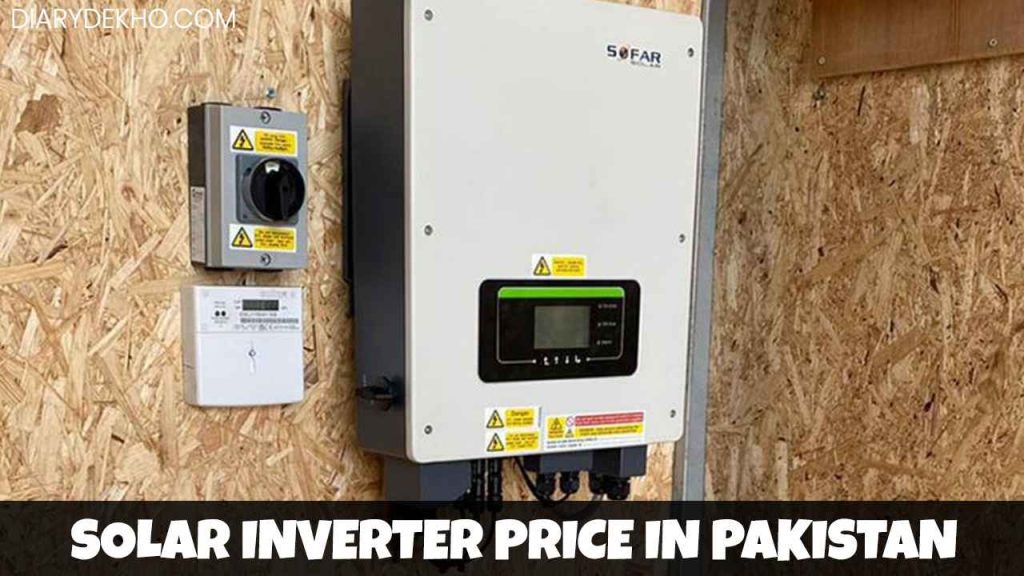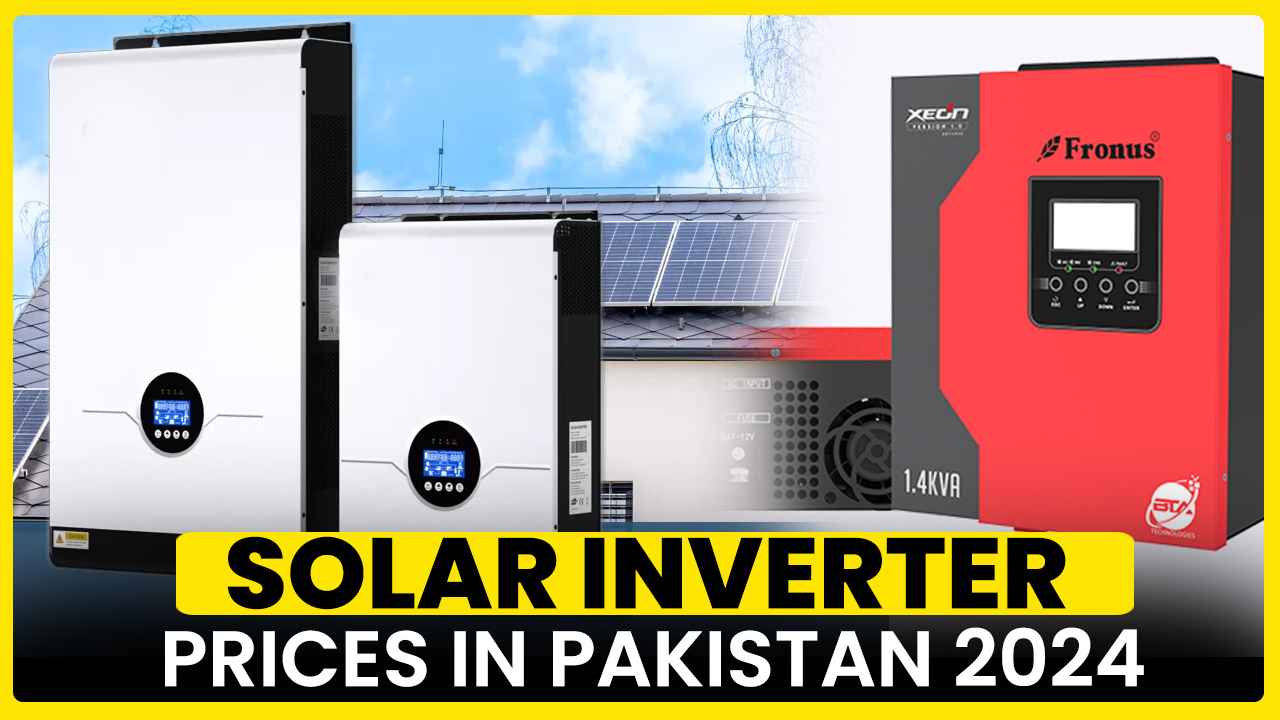Solar inverter Prices vary based on factors such as capacity, efficiency, and brand reputation. These devices are crucial components in solar energy systems. They convert the direct current (DC) electricity produced by solar panels into usable alternating current (AC) electricity. Whether for home or business setups, inverters serve as the heart of solar power systems. They optimize their performance and ensure proper utilization of solar energy.
This article discusses solar inverter Prices in Pakistan. It covers pricing variables, popular brands, government policies, market trends, and inverter selection suggestions. Solar inverter pricing ranges from 25,000 PKR to 465,000 PKR, therefore understanding it is crucial for sustainable energy investors.

Solar Inverter Prices in Pakistan
5kw Solar inverter Prices in Pakistan costs 25,000 – 465,000 Rupees. This large price range reflects the market’s variety of choices for different budgets and needs. From entry-level to premium inverters with complex functionality, there are choices for everyone. Understanding the pricing range allows consumers to make informed choices. They can invest in solar energy solutions that fit with their financial limits and performance expectations.
| Solar Inverter Model | Cost (PKR) |
|---|---|
| Inverex Veryon 6KW Solar Inverter | 260,000 PKR |
| Fronus PV 3200 Solar Inverter in Pakistan | 85,000 PKR |
| Fronus PV 7200 Solar Inverter Cost in Pakistan | 165,000 PKR |
| Inverex Veryon 2.5KW Solar Inverter Latest Rate | 100,000 PKR |
| Inverex Veryon 3.2KW Solar Inverter Rates in Pakistan | 165,000 PKR |
| Local Solar Inverters | 25,000 PKR – 95,000 PKR |
| Fronus PV 9200 Solar Inverter | 245,000 PKR |
| Ziewnic Z5 PV 8500 Inverter | 180,000 PKR |
| Fronus PV 5200 Solar Inverter | 135,000 PKR |
| Inverex Nitrox 8KW Hybrid Solar Inverter | 465,000 PKR |
| Inverex Veryon 1.2KW Solar Inverter | 75,000 PKR |
| Crown Xavier 5.6KW Hybrid Solar Inverter | 185,000 PKR |
| Fronus PV 2200 Solar Inverter | 55,000 PKR |
| Inverex Nitrox 6KW Hybrid Solar Inverter | 348,000 PKR |
| Fronus Platinum PV 12200 Solar Inverter Price in Pakistan | 315,000 PKR |
Also Read:
Today Solar Panel Prices in Pakistan
Types of Solar Inverters
There are various varieties of solar inverters available, each with its unique features and applications. Understanding the variations between these types is vital for choosing the correct inverter for your solar energy system.
String Inverters
String inverters are the most frequent form of inverters used in solar PV systems. They work by connecting many solar panels in series, forming a “string.” These inverters transform the DC electricity supplied by the complete string of panels into AC power. String inverters are cost-effective and excellent for home and business installations with unshaded areas.
Microinverters
Microinverters are mounted on each solar panel, converting the DC electricity right at the source. Unlike string inverters, microinverters work individually, allowing each panel to perform optimally even if others are shadowed or have performance concerns. Microinverters are suited for installations with shade or complex roof layouts, delivering enhanced performance and flexibility.
Power Optimizers + String Inverter
Power optimizers are devices positioned at the panel level to maximize the performance of each module. When paired with a string inverter, power optimizers alleviate the effect of shade and mismatched panels, boosting total system efficiency. This hybrid approach combines the benefits of both string inverters and microinverters, delivering better performance and flexibility.
On-grid Inverters
On-grid inverters, also known as grid-tied inverters, are meant to work in conjunction with the utility grid. They convert the DC power produced by solar panels into AC power, which is synchronized with the grid’s frequency and voltage. On-grid inverters allow solar energy installations to pump excess electricity back into the grid, allowing net metering and lowering reliance on utility power.
Off-grid Inverters
Off-grid inverters are used in freestanding solar PV systems that are not tied to the utility grid. These inverters convert DC power from solar panels into AC power for use in off-grid applications such as distant dwellings, lodges, or telecommunications equipment. Off-grid inverters often add battery storage to store extra energy for usage when sunlight is not available.
Tips for Buying a Solar Inverter
When selecting a solar inverter, consider these important suggestions to make the greatest option for your solar energy system.
- Assess Your Energy Needs: Determine your system’s power requirements to verify that the inverter you choose can meet them successfully.
- Research Brand Reputation: Select a reputed brand known for dependability and quality to ensure long-term success and client support.
- Check compatibility: To avoid compatibility issues, ensure that the inverter and other system components, such as solar panels and batteries, work properly.
- Evaluate warranty coverage: Look for inverters with extended warranties to protect your investment and provide peace of mind.
- Seek Professional Advice: Speak with solar energy professionals or installers to get expert advice tailored to your specific needs and circumstances.
Impact of Government Policies and Incentives
Government rules and incentives play a key role in setting the solar inverter rates in the market. Firstly, they impact the demand and supply dynamics, modifying the whole pricing structure of solar energy components, including inverters. Secondly, laws like as import tariffs or levies directly affect the cost of importing inverters, consequently impacting their retail costs in the local market.
Additionally, governments often offer grants and tax benefits to promote the adoption of solar energy systems, including inverters. These incentives can offset the initial investment expenses for clients, making solar inverter Prices more affordable and attractive. By eliminating the financial impediments to entrance, subsidies and tax incentives encourage more individuals and businesses to invest in solar energy solutions, boosting market demand and competition among manufacturers.
Top Popular Solar Inverter Brands in Pakistan
- Inverex inverters
- Growatt inverters
- Solis inverter
- SolarMax inverters
- Huawei inverters
- Sofar inverters
- GoodWe inverters
- Sungrow inverters
- Fronius inverters
- Solax inverters
Also Read:
Water Dispenser Price in Pakistan
Conclusion: Solar Inverter Prices in Pakistan
Understanding solar inverter pricing in Pakistan is important for making sound investment choices in solar energy. Brand image, capacity, and government incentives are all factors that influence costs. Consumers may contribute to a sustainable energy future by assessing their needs, studying products, and considering compatibility when choosing an inverter.
Frequently Asked Questions (FAQs)
Solar inverter Prices in Pakistan can vary depending on the brand, size (capacity), and type (hybrid or grid-tie). Prices can range from 25,000 PKR to 465,000 PKR.
Some popular solar inverter brands in Pakistan include Fronus, Growatt, SolarMax, Crown, and Inverex solar inverter Price in Pakistan.
You can find solar inverter prices online on retailer websites or marketplaces like Daraz.pk or by contacting solar panel installation companies in your area.
Several factors can affect the Solar Inverter Prices, including:
Capacity (kW): Larger inverters are generally more expensive.
Brand: More well-known brands may cost slightly more.
Type: Hybrid inverters, which can store solar energy in batteries, are typically more expensive than grid-tie inverters.
Features: Inverters with additional features, such as monitoring capabilities, may cost more.
Not necessarily. While a larger inverter can handle more solar panels, you may not need that much capacity if your current energy needs are low. It’s best to size the inverter based on your specific requirements to avoid unnecessary expense.
